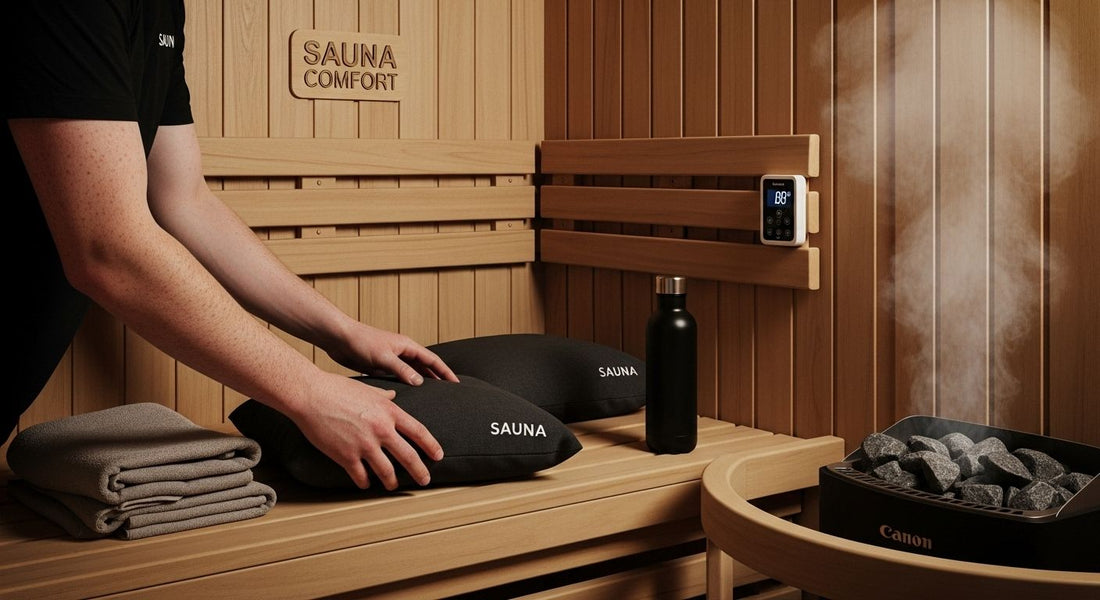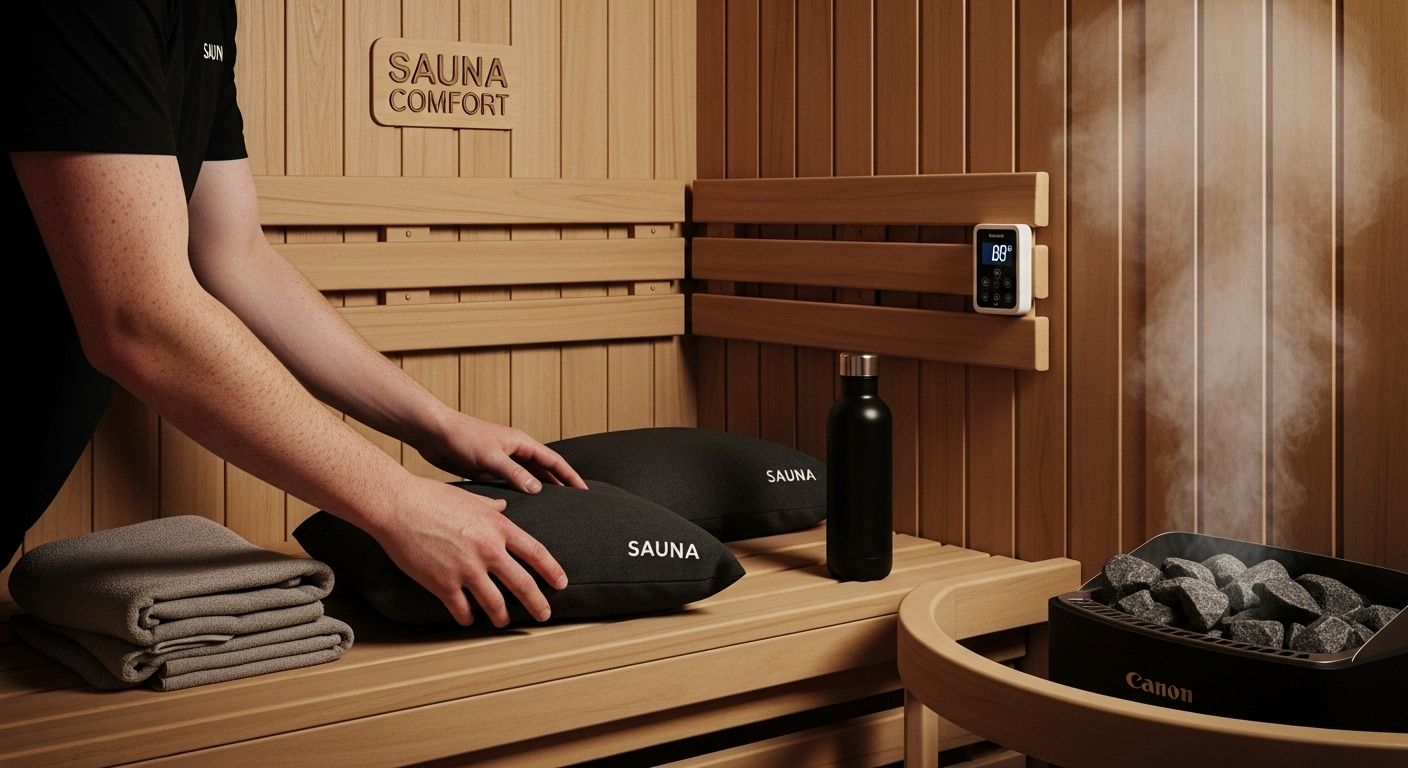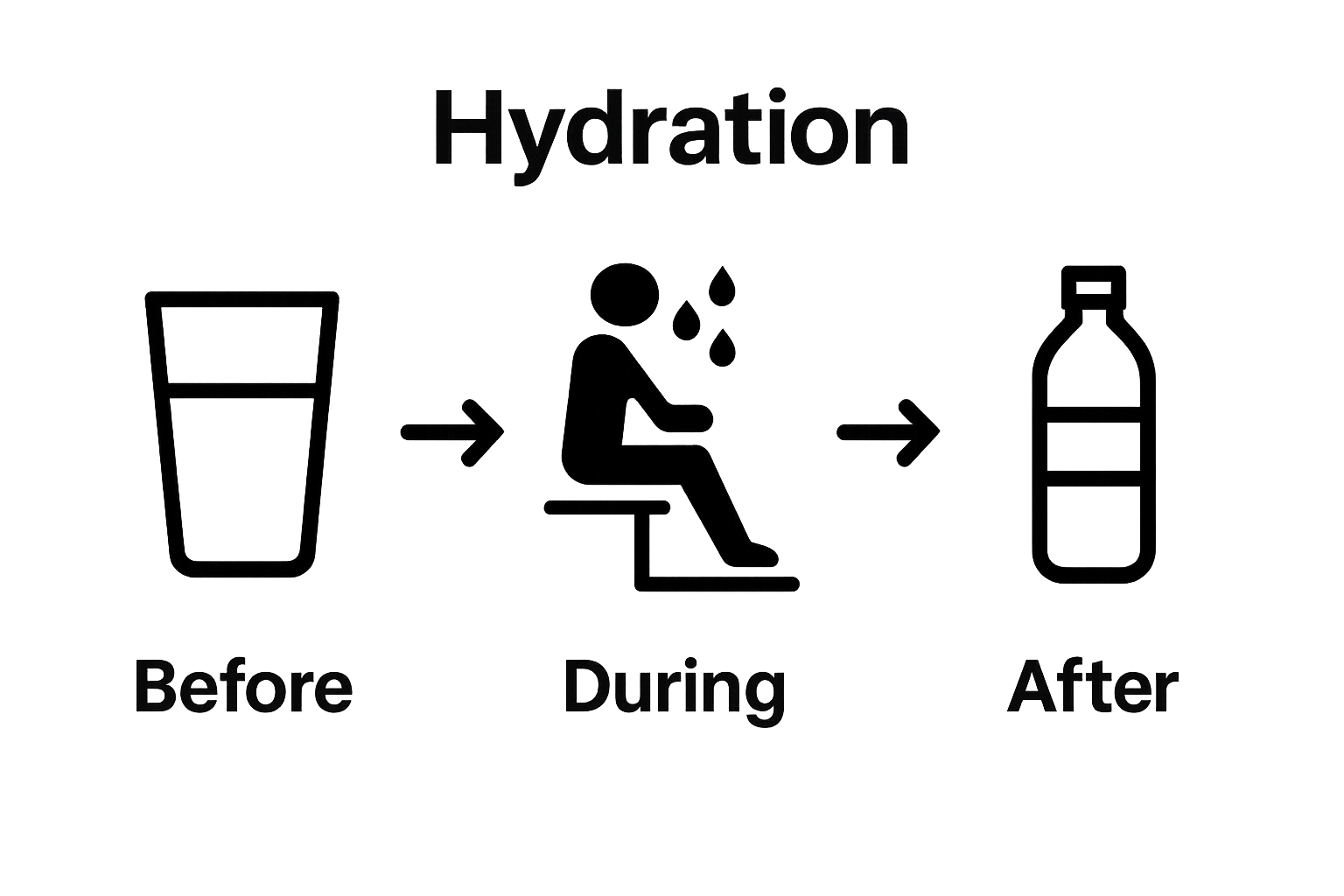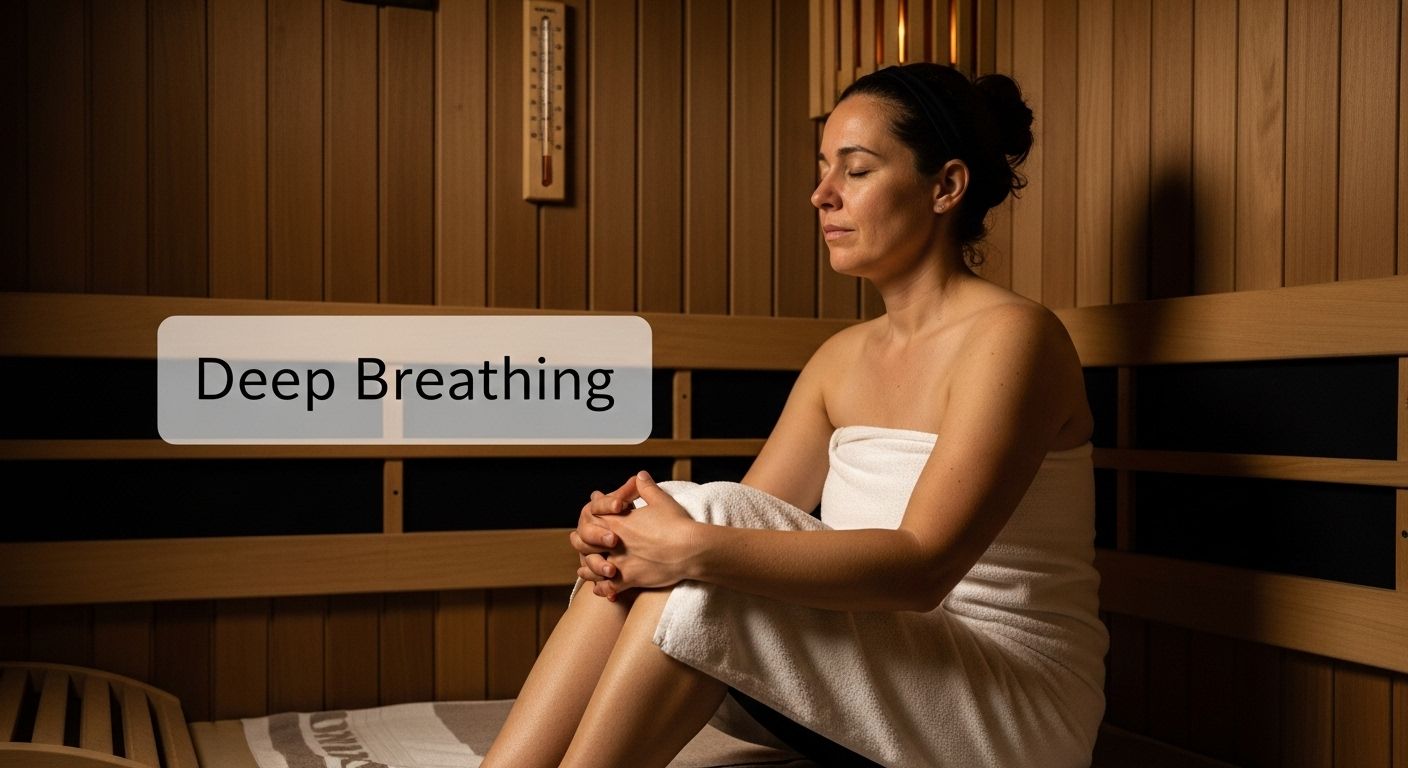
How to Relax in Sauna: A Step-by-Step Guide to Serenity

Getting into a sauna feels like stepping into your own private spa, and most people do not know that the ideal sauna temperature falls between 150 and 195 degrees Fahrenheit. You might think all it takes is flipping a switch and sitting back. Actually, the secrets to a truly restorative sauna session start long before you close that door. Before you settle in for a sweat, a few simple steps will make the difference between feeling wilted and feeling completely renewed.
Table of Contents
- Step 1: Prepare Your Sauna Space for Maximum Comfort
- Step 2: Select the Right Temperature and Timing Settings
- Step 3: Hydrate Your Body Before Entering the Sauna
- Step 4: Practice Deep Breathing and Mindfulness Inside the Sauna
- Step 5: Cool Down Safely After Your Sauna Session
- Step 6: Reflect on Your Experience to Enhance Future Sessions
Quick Summary
| Key Point | Explanation |
|---|---|
| 1. Prepare sauna for comfort | Ensure proper temperature and ventilation for an enjoyable sauna experience. Check air circulation and maintain temperatures between 150 and 195 degrees Fahrenheit. |
| 2. Hydrate before your session | Drink 16 to 20 ounces of water two hours prior to using the sauna to prevent overheating and ensure optimal hydration. |
| 3. Practice mindful breathing | Use deep breathing techniques to enhance relaxation and regulate your body’s response to heat during your sauna session. |
| 4. Gradually cool down after sauna | Cool down slowly by allowing your body to adjust temperature naturally and rehydrate immediately to restore fluid balance. |
| 5. Reflect on your sauna experience | Documenting your sessions helps identify patterns and improve future sauna practices, enhancing overall wellness and relaxation. |
Step 1: Prepare Your Sauna Space for Maximum Comfort
Creating the perfect sauna experience begins with thoughtful preparation, transforming your space into a sanctuary of relaxation and wellness. Before stepping into the soothing warmth, you need to establish an environment that promotes total comfort and tranquility.
Temperature and Ventilation Essentials
Preparing your sauna space starts with understanding its thermal dynamics. According to InterNACHI’s sauna guidelines, proper ventilation is crucial for maintaining a safe and comfortable environment. Begin by checking your sauna’s air circulation system, ensuring there are adequate intake and exhaust points to prevent stagnant heat buildup.
Temperature control is your next critical consideration. Most saunas operate best between 150 and 195 degrees Fahrenheit, but personal comfort varies. If you’re new to sauna sessions, start at the lower end of this range and gradually increase heat as you become more accustomed. Install a reliable thermometer to monitor temperatures precisely, helping you create a consistent and enjoyable experience.
Creating a Serene Atmosphere
Beyond technical preparations, crafting a peaceful ambiance dramatically enhances your relaxation. Choose soft, absorbent towels to sit on, preventing moisture accumulation and providing a comfortable surface. Consider bringing a small water-resistant cushion if you prefer extra padding. Keep a separate towel nearby for gentle moisture management during your session.
Organize your sauna space with minimal clutter. Place a small water bottle within easy reach to stay hydrated, and if your sauna allows, consider adding subtle aromatherapy elements like cedar wood chips or lavender sachets to engage multiple senses and deepen your relaxation experience. Remember that simplicity is key when preparing your sauna space optimal comfort and mindful unwinding.
By meticulously preparing your sauna environment, you set the stage for a transformative wellness experience that nurtures both body and mind.
Here is a step overview table summarizing each main step in the sauna relaxation process, including suggested time ranges and the purpose of each step to help you plan your session effectively.
| Step | Estimated Time | Purpose |
|---|---|---|
| Prepare sauna space | 5-10 minutes | Create a comfortable and tranquil environment |
| Select temperature/timing | 2-3 minutes | Ensure safe, customized heat exposure and session duration |
| Hydrate before entering | 2 hours before (ongoing) | Prevent dehydration and support body cooling mechanisms |
| Deep breathing/mindfulness | Entire session | Enhance relaxation and regulate response to heat |
| Cool down safely | 10-15 minutes | Gradually restore body temperature and rehydrate |
| Reflect on experience | 5-10 minutes | Improve future sessions through documentation and analysis |
Step 2: Select the Right Temperature and Timing Settings
Choosing the ideal temperature and timing for your sauna session is an art form that balances personal comfort, health considerations, and physiological response. This critical step transforms a simple heat exposure into a strategic wellness practice that maximizes relaxation and potential health benefits.
Understanding Temperature Dynamics
Temperature selection requires a nuanced approach that respects individual tolerance and wellness goals. According to guidelines from the Centers for Disease Control and Prevention, monitoring heat exposure is crucial for preventing potential health risks. For most individuals, the sweet spot for sauna temperatures ranges between 150 and 195 degrees Fahrenheit. Beginners should start at the lower end of this spectrum, typically around 150 to 165 degrees, gradually increasing heat tolerance with repeated sessions.
Your personal comfort and physical condition dictate precise temperature settings. Those with cardiovascular concerns or limited heat tolerance might prefer staying closer to 150 degrees, while experienced sauna enthusiasts can comfortably explore temperatures approaching 195 degrees. Listen to your body and avoid pushing beyond your individual comfort threshold. A digital thermometer provides precise temperature tracking, helping you maintain consistent and safe heat levels throughout your session.
Mastering Session Duration
Time management is equally important as temperature control. Initial sauna sessions should be relatively short, typically 10 to 15 minutes, allowing your body to acclimate to intense heat exposure. Advanced users might extend sessions to 20 or 25 minutes, but never exceed 30 minutes in a single continuous session. Breaks are essential in longer experiences practical strategy involves alternating between sauna heat and cooling periods, which helps regulate body temperature and enhance overall cardiovascular response.
Beginners should follow a progressive approach. Start with 10-minute sessions, paying close attention to how your body responds. Hydration is paramount watch for signs of overheating such as excessive sweating, dizziness, or discomfort. As you become more experienced, you can gradually increase session length and temperature, always maintaining a mindful and responsive approach to your body’s signals. Remember that sauna use is a personal journey of wellness and relaxation, not an endurance competition.
Step 3: Hydrate Your Body Before Entering the Sauna
Hydration is the cornerstone of a safe and effective sauna experience, acting as your body’s primary defense mechanism against potential heat stress and ensuring optimal physiological performance. Understanding how to properly prepare your body with fluids is more than just drinking water it is a strategic approach to wellness and comfort.
The Science of Pre Sauna Hydration
According to Cleveland Clinic’s health guidelines, hydration before sauna sessions is critical for preventing potential health risks associated with intense heat exposure. Your body will lose significant amounts of water through sweating, making pre session hydration essential. Aim to drink approximately 16 to 20 ounces of water in the two hours leading up to your sauna session, creating a robust hydration foundation that supports your body’s natural cooling mechanisms.
Avoid consuming large quantities of water immediately before entering the sauna, as this can cause discomfort. Instead, focus on steady and consistent fluid intake throughout the day. Water is your primary hydration source, but you can also incorporate electrolyte rich beverages that help maintain mineral balance. Coconut water, herbal teas, and diluted sports drinks can provide additional hydration support while replenishing essential minerals lost through sweating.
Strategic Hydration Preparation
Preparing for sauna hydration extends beyond drinking water. Consider your overall fluid intake in the 24 hours preceding your session. Individuals who maintain consistent hydration levels experience more comfortable and effective sauna experiences. If you know you will be using the sauna, gradually increase your water consumption in the days leading up to the session. This approach helps your body become more efficient at regulating temperature and managing fluid loss.
Pay attention to your body’s signals. Dark yellow urine indicates dehydration, while pale yellow or clear urine suggests proper hydration. Drink water consistently, but avoid overhydration, which can cause its own set of complications. Your goal is to enter the sauna in a balanced state of hydration feeling refreshed, alert, and ready to embrace the therapeutic heat. By treating hydration as a deliberate and thoughtful process, you transform a simple act of drinking water into a powerful wellness strategy.
Below is a checklist table to help ensure you complete all key preparations and actions before, during, and after your sauna session. Use this to maximize both comfort and safety.
| Task | When to Complete | Done (✔/✘) |
|---|---|---|
| Check air circulation and ventilation | Before session | |
| Set sauna temperature (150-195°F) | Before session | |
| Have towels and water bottle nearby | Before session | |
| Drink 16-20 oz water in advance | 2 hours before session | |
| Practice deep breathing/mindfulness | During session | |
| Cool down gradually | After session | |
| Rehydrate after sauna | After session | |
| Document experience in a journal | After session |

Step 4: Practice Deep Breathing and Mindfulness Inside the Sauna
The sauna offers more than physical warmth it provides a unique sanctuary for mental reset and profound relaxation. Transforming your sauna experience from a simple heat session into a mindful practice requires intentional breathing and mental focus that can dramatically enhance your overall wellness journey.
Understanding Mindful Breathing Techniques
According to Harvard Health, breath meditation serves as a powerful tool for stress reduction. In the sauna’s intense environment, deep breathing becomes your anchor, helping regulate body temperature and calm your nervous system. Begin by establishing a rhythmic breathing pattern: inhale slowly through your nose for four counts, hold for two counts, then exhale deliberately through your mouth for six counts. This controlled breathing technique helps your body adapt to heat while simultaneously promoting mental tranquility.
The key is consistency and awareness. As heat surrounds you, focus entirely on your breath. Notice the sensation of warm air entering your lungs, the subtle expansion of your chest, and the gradual release of tension with each exhale. Your breath becomes a meditation practice, transforming the sauna from a physical space into a mindfulness retreat.
Cultivating Inner Stillness
Mindfulness in the sauna extends beyond breathing techniques. Use this time to practice mental quieting strategies. Visualize a peaceful landscape calm ocean waves, serene mountain vistas, or a quiet forest clearing. Allow these mental images to replace any stress or racing thoughts. Some practitioners find success in body scanning techniques gently bringing awareness to each part of your body, observing sensations without judgment.
If your mind wanders, which is completely normal, gently redirect your attention back to your breath. Treat intrusive thoughts like passing clouds simply acknowledge them and let them drift away. The sauna becomes a microcosm of personal peace a controlled environment where you can practice emotional regulation and mental clarity. By the end of your session, you will have not just cleansed your body but also refreshed your mind, emerging with a sense of renewed energy and inner calm.

Step 5: Cool Down Safely After Your Sauna Session
The moments following your sauna session are just as crucial as the time spent inside the heated environment. Cooling down represents a delicate physiological transition that requires mindful attention and strategic approach to ensure your body returns to its normal state safely and effectively.
Understanding the Cooling Process
According to Harvard Health, gradual temperature reduction is essential to prevent potential cardiovascular stress and dizziness. Immediate cooling should be gentle and controlled, avoiding sudden temperature shifts that could shock your system. Begin by stepping out of the sauna and allowing your body to naturally start dissipating heat. Find a comfortable area with room temperature air, positioning yourself where you can sit or stand without feeling rushed.
Your first priority is restoring fluid balance. Keep your previously prepared water nearby and start rehydrating immediately. Take slow, deliberate sips rather than gulping large quantities. Your body will be experiencing increased blood flow and potential perspiration, so replenishing lost fluids becomes paramount. Consider having an additional towel ready to gently pat away excess moisture, helping your body regulate its temperature more efficiently.
Practical Cooling Strategies
Consider incorporating a strategic cooling approach that engages multiple sensory experiences. If available, a lukewarm shower can help normalize your body temperature more rapidly than standing in room air. Some wellness enthusiasts practice contrast therapy by alternating between warm and cool environments, which can enhance circulation and provide an invigorating physiological response. For those with access to a cold plunge or shower, brief exposure can stimulate your cardiovascular system and potentially boost recovery.
Pay close attention to your body’s signals during this transition. Lightheadedness, excessive sweating, or feeling unusually weak are signs that you should sit down and continue hydrating. Your cooling period is not just a physical process but a moment of gentle transition. Move slowly, breathe deliberately, and allow your body to recalibrate. The goal is to emerge from your sauna experience feeling refreshed, balanced, and restored rather than depleted or overwhelmed.
Step 6: Reflect on Your Experience to Enhance Future Sessions
Reflection transforms a simple sauna session from a routine activity into a profound journey of self discovery and personal wellness. By thoughtfully analyzing your experience, you create a powerful feedback loop that continuously improves your approach to relaxation, stress management, and physical recovery.
Documenting Your Sauna Journey
According to research published in Stress Health, self reflection can provide complex insights into personal coping mechanisms and stress responses. Immediately after your session, find a quiet space and spend 5 to 10 minutes recording your observations. Keep a dedicated sauna journal where you can track key details such as session duration, temperature, how your body felt, and your mental state before and after. Note physical sensations like muscle tension release, changes in breathing, or unexpected emotional responses.
Consider creating a simple rating system for your sessions. Rate aspects like relaxation level, physical comfort, mental clarity, and overall experience on a scale of 1 to 10. This quantitative approach allows you to identify patterns and track your progress over time. Was this session more or less comfortable than previous ones? Did you notice improvements in your ability to manage heat or practice mindfulness?
Developing Personal Sauna Strategies
Reflection is not just about recording experiences it is about learning and adapting. Use your journal entries to develop personalized strategies for future sauna sessions. If you consistently feel dizzy during sessions, this might indicate a need to adjust hydration practices or reduce session duration. Observe how different breathing techniques impact your comfort level and mental state.
Remember that your sauna journey is uniquely yours. What works perfectly for one person might require slight modifications for another. Pay attention to subtle changes in your body’s response to heat, your mental resilience, and your overall sense of well being. By treating each sauna session as a learning opportunity, you transform a simple wellness practice into a sophisticated personal development tool that evolves with your growing understanding of your own physical and mental landscape.
Bring Ultimate Serenity Home With Premium Sauna Solutions
You have just learned how thoughtful preparation, the right temperature settings, and mindfulness can transform your sauna session into a restorative ritual. Many readers, however, struggle to find a reliable way to create such a calming environment at home. Common pain points like uncomfortable seating, inconsistent heat, and lack of suitable accessories often get in the way of truly letting go. At Best Life Sauna, we provide everything you need for a perfect home spa experience, including carefully crafted infrared and traditional saunas, high-quality accessories, and even cold plunge tubs to help you master every step of the relaxation process described in this guide.

Elevate your wellness journey today. Shop directly at Best Life Sauna and take advantage of free shipping on orders over $200 and our price match guarantee. Explore our selection to create a sanctuary that aligns with your personal routine and the step-by-step techniques outlined in this article. Visit the Best Life Sauna homepage now to discover your path to daily calm and well-being.
Frequently Asked Questions
How should I prepare my sauna space for comfort?
To prepare your sauna space, check the air circulation and ensure proper ventilation. Aim for a temperature between 150 and 195 degrees Fahrenheit. Use soft towels and minimize clutter for a peaceful atmosphere.
What is the ideal temperature for beginners in the sauna?
Beginners should start with sauna temperatures around 150 to 165 degrees Fahrenheit to gradually acclimate to the heat. Monitor your comfort levels and adjust as needed.
How important is hydration before entering the sauna?
Hydration is crucial before sauna sessions. Aim to drink 16 to 20 ounces of water in the two hours leading up to your session to support your body’s cooling mechanisms and prevent dehydration.
What are effective mindfulness techniques to use in the sauna?
In the sauna, practice deep breathing techniques by inhaling through your nose and exhaling through your mouth. Focus on your breath, visualize calming images, and gently redirect your thoughts to maintain a state of mindfulness during your session.

